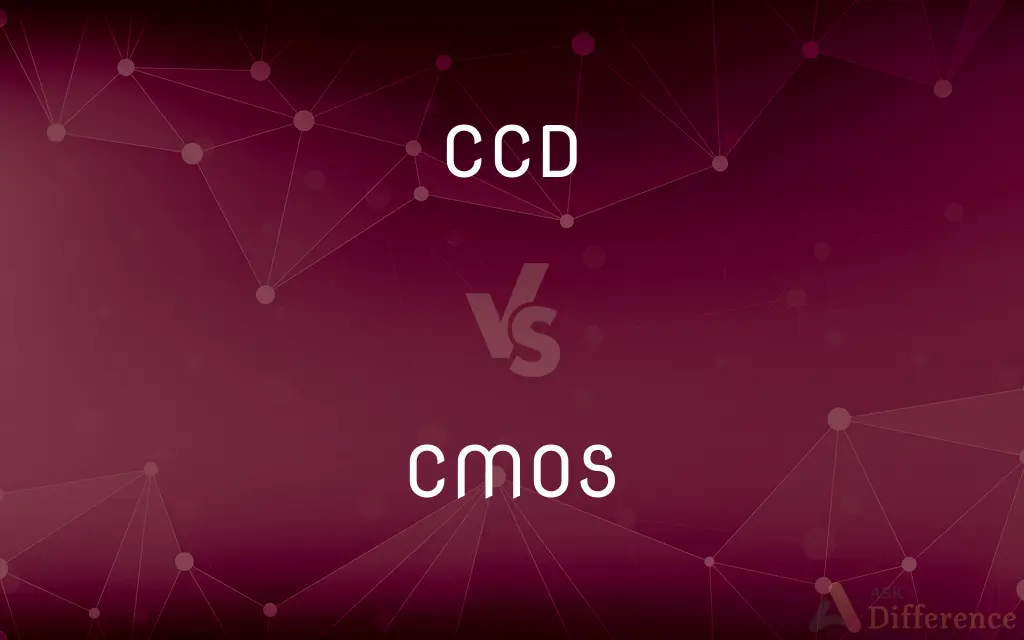CCD vs. CMOS — What's the Difference?
By Tayyaba Rehman & Urooj Arif — Published on February 14, 2024
CCD (Charge-Coupled Device) and CMOS (Complementary Metal-Oxide-Semiconductor) are types of image sensors. CCDs are known for higher quality images and sensitivity, while CMOS sensors offer lower power consumption and cost.

Difference Between CCD and CMOS
Table of Contents
ADVERTISEMENT
Key Differences
CCD (Charge-Coupled Device) and CMOS (Complementary Metal-Oxide-Semiconductor) sensors are two pivotal technologies in digital imaging, each with distinct characteristics and applications. CCD sensors are renowned for their exceptional image quality and light sensitivity, making them the preferred choice in environments where capturing the finest details is crucial, such as in astrophotography and high-quality scanners. The technology behind CCDs involves moving charged electrical signals through the chip to its edge, where they are processed, which, while delivering high-quality images, typically results in higher power consumption.
On the other hand, CMOS sensors integrate several transistors at each pixel site, allowing for more rapid processing of the electrical signals directly at the pixel level. This architecture not only reduces power consumption but also speeds up the processing time, making CMOS sensors highly suitable for applications where power efficiency and speed are critical, such as in consumer electronics and mobile devices. The trade-off, historically, has been that CMOS sensors didn't match CCDs in image quality, although advancements in technology have significantly narrowed this gap.
One of the key differences between CCD and CMOS sensors lies in their manufacturing processes. CCD sensors are more complex and expensive to produce, as their fabrication requires specialized manufacturing facilities. In contrast, CMOS sensors can be manufactured using standard semiconductor production lines, which significantly reduces their cost. This cost-effectiveness has led to the widespread adoption of CMOS sensors in a broad range of devices, from smartphones to DSLR cameras.
In terms of energy consumption, CCDs generally require higher power, making them less suited for battery-operated devices. CMOS sensors, with their lower power requirements, are more adaptable to a variety of applications, especially in portable devices. Additionally, CMOS technology supports on-chip integration of other functions such as analog-to-digital conversion, which further enhances its efficiency and versatility.
In summary, while CCD sensors are prized for their superior image quality and sensitivity, CMOS sensors offer advantages in terms of cost, power efficiency, and speed. The choice between CCD and CMOS depends on the specific requirements of the application, including considerations of image quality, power consumption, speed, and cost.
ADVERTISEMENT
Comparison Chart
Image Quality
Higher, especially in low light
Historically lower, but improving
Power Consumption
Higher
Lower
Cost
More expensive to produce
Less expensive, benefits from economies of scale
Processing Speed
Slower due to off-chip processing
Faster due to on-chip processing
Manufacturing Process
Requires specialized facilities
Compatible with standard semiconductor processes
Compare with Definitions
CCD
An image sensor technology known for high-quality images.
The CCD sensor in the telescope captured detailed images of the galaxy.
CMOS
A versatile image sensor technology with lower power requirements.
The CMOS sensor in my smartphone enables long battery life even with frequent camera use.
CCD
More expensive to manufacture than CMOS sensors.
Due to its complex production process, CCD sensors are costlier.
CMOS
Integrates multiple transistors at each pixel for faster processing.
Thanks to on-chip processing, CMOS sensors quickly capture a series of photos.
CCD
Characterized by higher power consumption.
The CCD camera requires more power, limiting its use in portable devices.
CMOS
Cost-effective due to compatibility with standard manufacturing.
The affordability of CMOS cameras has revolutionized consumer electronics.
CCD
Utilizes a process where charge is transferred through the chip.
The CCD's unique charge transfer capability contributes to its superior image resolution.
CMOS
Enables integration of additional functions like analog-to-digital conversion.
The CMOS sensor's on-chip ADC simplifies the camera's circuitry.
CCD
Preferred in professional and scientific imaging devices.
High-end digital cameras often use CCD sensors for their image clarity.
CMOS
Continuously improving in image quality to rival CCDs.
Modern CMOS sensors now match the image quality of CCDs in many applications.
Common Curiosities
Why do CCD sensors consume more power?
The charge transfer process in CCDs is less energy-efficient, leading to higher power consumption.
Why are CCD sensors considered better in low light?
CCDs have superior light sensitivity and lower noise, enhancing low-light performance.
What does CCD stand for?
CCD stands for Charge-Coupled Device.
What does CMOS stand for?
CMOS stands for Complementary Metal-Oxide-Semiconductor.
Can CMOS sensors be used in professional cameras?
Yes, advancements in CMOS technology have made them suitable for professional use.
Is image quality from CMOS sensors catching up to CCDs?
Yes, the gap in image quality between CMOS and CCD sensors has significantly narrowed.
What are the main applications of CCD sensors?
CCD sensors are often used in scientific, medical imaging, and high-end photography.
Do both CCD and CMOS sensors have blooming issues?
While both can experience blooming, CCDs are generally more prone to it due to their structure.
Are CMOS sensors cheaper than CCD sensors?
Yes, CMOS sensors are generally cheaper due to lower production costs.
What is the future of CCD sensors?
CCDs continue to be preferred in niche applications requiring the highest image quality.
How does temperature affect CCD and CMOS sensors?
Both sensors can be affected by temperature, but CCDs are more sensitive to temperature-related noise.
What makes CMOS sensors fast?
On-chip processing in CMOS sensors allows for faster readout speeds.
Are CMOS sensors now dominant in the camera market?
Yes, due to their cost-effectiveness and versatility, CMOS sensors dominate most consumer camera markets.
How have CMOS sensors improved over time?
Technological advancements have enhanced CMOS sensors' image quality and reduced noise.
Can CCD sensors be used in mobile phones?
Due to their higher power consumption, CCDs are less common in battery-powered devices like phones.
Share Your Discovery

Previous Comparison
Anti-Federalist vs. Federalist
Next Comparison
Judicial Foreclosure vs. Non-Judicial ForeclosureAuthor Spotlight
Written by
Tayyaba RehmanTayyaba Rehman is a distinguished writer, currently serving as a primary contributor to askdifference.com. As a researcher in semantics and etymology, Tayyaba's passion for the complexity of languages and their distinctions has found a perfect home on the platform. Tayyaba delves into the intricacies of language, distinguishing between commonly confused words and phrases, thereby providing clarity for readers worldwide.
Co-written by
Urooj ArifUrooj is a skilled content writer at Ask Difference, known for her exceptional ability to simplify complex topics into engaging and informative content. With a passion for research and a flair for clear, concise writing, she consistently delivers articles that resonate with our diverse audience.
















































